

Compact Muon Solenoid
LHC, CERN
| CMS-EXO-20-009 ; CERN-EP-2021-264 | ||
| Search for long-lived heavy neutral leptons with displaced vertices in proton-proton collisions at $\sqrt{s} = $ 13 TeV | ||
| CMS Collaboration | ||
| 14 January 2022 | ||
| JHEP 07 (2022) 081 | ||
| Abstract: A search for heavy neutral leptons (HNLs), the right-handed Dirac or Majorana neutrinos, is performed in final states with three charged leptons (electrons or muons) using proton-proton collision data collected by the CMS experiment at $\sqrt{s} = $ 13 TeV at the CERN LHC. The data correspond to an integrated luminosity of 138 fb$^{-1}$. The HNLs could be produced through mixing with standard model neutrinos $\nu$. For small values of the HNL mass ($ < $ 20 GeV) and the square of the HNL-$\nu$ mixing parameter (10$^{-7}$-10$^{-2}$), the decay length of these particles can be large enough so that the secondary vertex of the HNL decay can be resolved with the CMS silicon tracker. The selected final state consists of one lepton emerging from the primary proton-proton collision vertex, and two leptons forming a displaced, secondary vertex. No significant deviations from the standard model expectations are observed, and constraints are obtained on the HNL mass and coupling strength parameters, excluding previously unexplored regions of parameter space in the mass range 1-20 GeV and squared mixing parameter values as low as 10$^{-7}$. | ||
| Links: e-print arXiv:2201.05578 [hep-ex] (PDF) ; CDS record ; inSPIRE record ; HepData record ; CADI line (restricted) ; | ||
| Figures & Tables | Summary | Additional Figures & Tables | References | CMS Publications |
|---|
| Figures | |
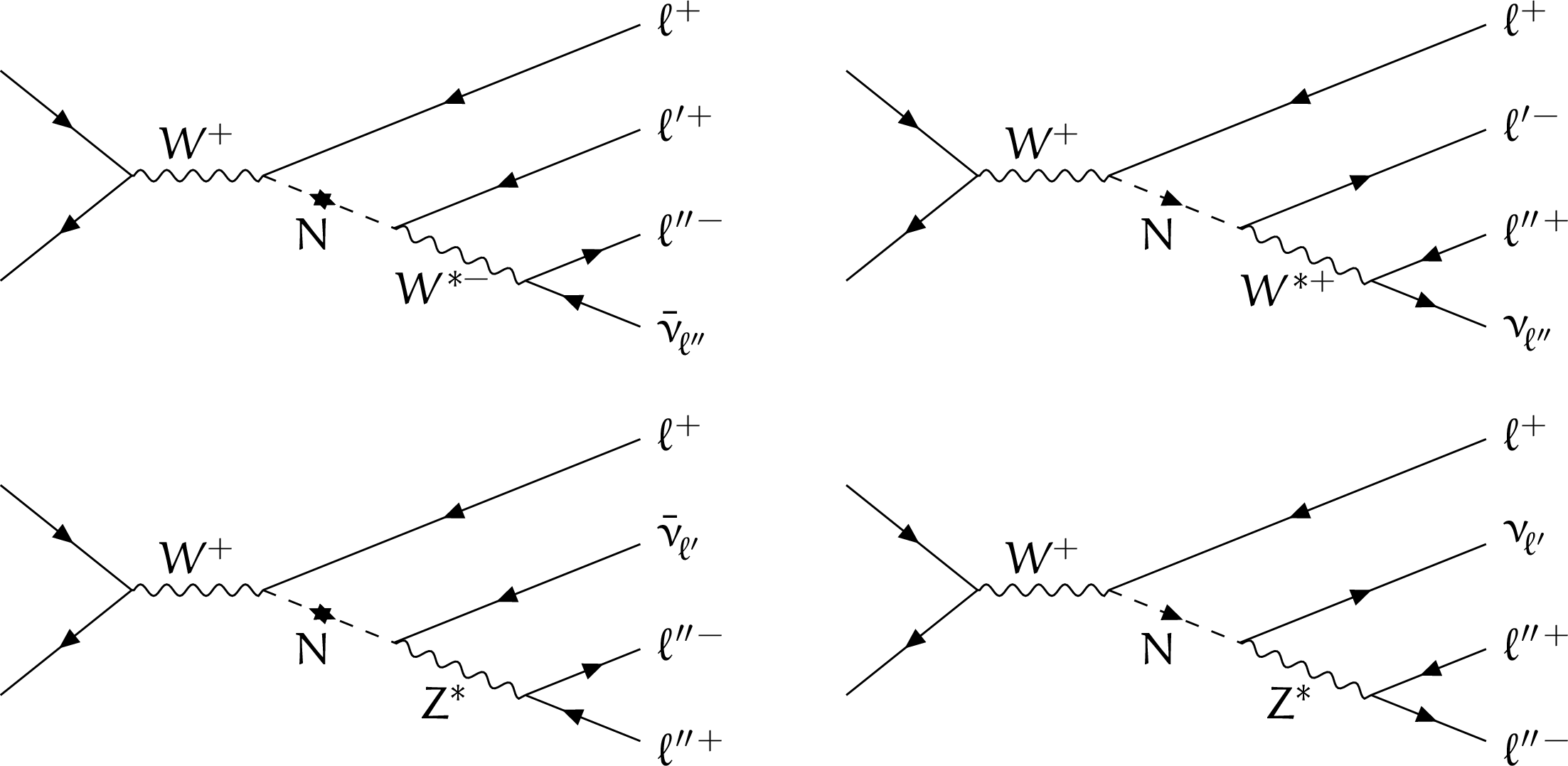
png pdf |
Figure 1:
Typical diagrams for the production and decay of an HNL through its mixing with an SM neutrino, leading to final states with three charged leptons and a neutrino. The HNL decay is mediated by either a W* (upper row) or a Z* (lower row) boson. In the diagrams on the left, the HNL is assumed to be a Majorana neutrino, thus $\ell$ and $\ell'$ in the W*-mediated diagram can have the same electric charge, and lepton number can be violated. In the diagrams on the right, the HNL decay conserves lepton number and can be either a Majorana or a Dirac particle, and, therefore, $\ell$ and $\ell'$ in the W*-mediated diagram have always opposite charge. The present study only considers the LNC case, thus $\ell$ and $\ell'$ (or $\nu_{\ell'}$) are always of the same flavor. In the case of the HNL decay mediated by a Z* boson, only the case where $\ell$ and $\ell''$ are of the same flavor is considered. |
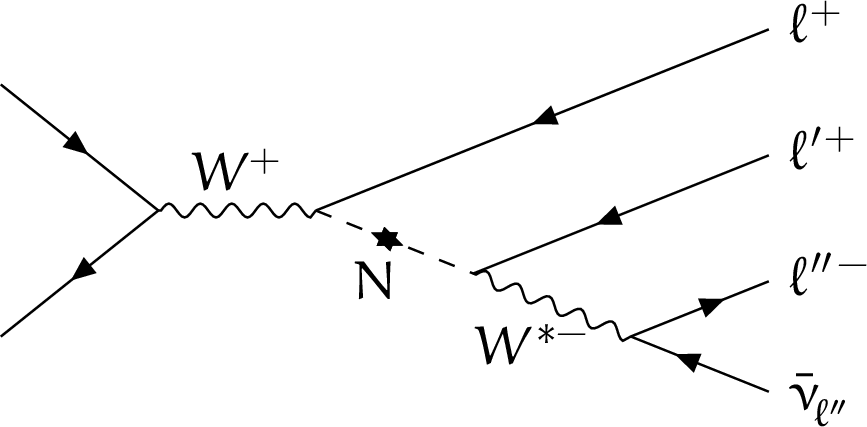
png pdf |
Figure 1-a:
Typical diagram for the production and decay of an HNL through its mixing with an SM neutrino, leading to final states with three charged leptons and a neutrino. Here, the HNL decay is mediated by a W* boson. The HNL is assumed to be a Majorana neutrino, thus $\ell$ and $\ell'$ can have the same electric charge, and lepton number can be violated. The present study only considers the LNC case, thus $\ell$ and $\ell'$ are always of the same flavor. |

png pdf |
Figure 1-b:
Typical diagram for the production and decay of an HNL through its mixing with an SM neutrino, leading to final states with three charged leptons and a neutrino. Here, the HNL decay is mediated by a W* boson. The HNL decay conserves lepton number and can be either a Majorana or a Dirac particle, and, therefore, $\ell$ and $\ell'$ have always opposite charge. The present study only considers the LNC case, thus $\ell$ and $\ell'$ are always of the same flavor. |
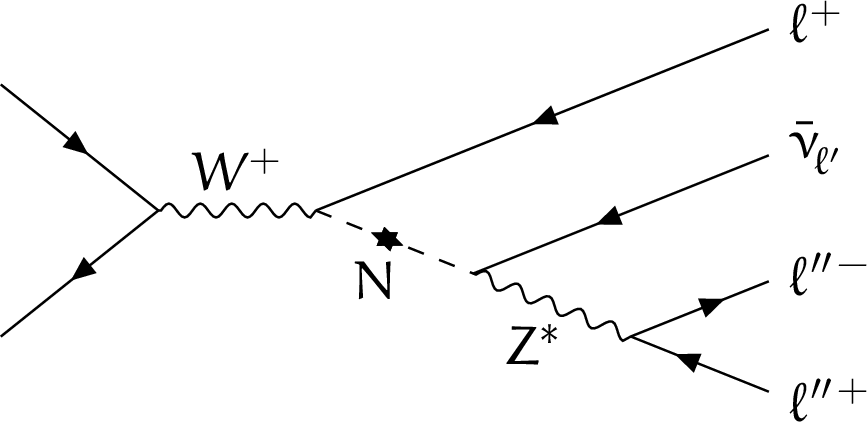
png pdf |
Figure 1-c:
Typical diagram for the production and decay of an HNL through its mixing with an SM neutrino, leading to final states with three charged leptons and a neutrino. Here, the HNL decay is mediated by a Z* boson. The HNL is assumed to be a Majorana neutrino. The present study only considers the LNC case, thus $\ell$ and $\nu_{\ell'}$ are always of the same flavor. In the case of the HNL decay mediated by a Z* boson, only the case where $\ell$ and $\ell''$ are of the same flavor is considered. |
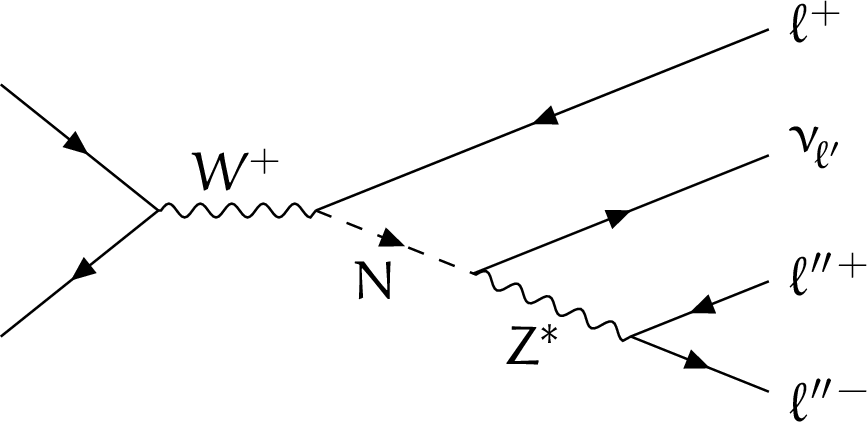
png pdf |
Figure 1-d:
Typical diagram for the production and decay of an HNL through its mixing with an SM neutrino, leading to final states with three charged leptons and a neutrino. Here, the HNL decay is mediated by a Z* boson. The HNL decay conserves lepton number and can be either a Majorana or a Dirac particle. The present study only considers the LNC case, thus $\ell$ and $\nu_{\ell'}$ are always of the same flavor. In the case of the HNL decay mediated by a Z* boson, only the case where $\ell$ and $\ell''$ are of the same flavor is considered. |

png pdf |
Figure 2:
Distribution of kinematic properties of the generated leptons for simulated HNL signal events: the ${p_{\mathrm {T}}}$ of ${\ell _3}$ (left), the $m({\ell _2} {\ell _3})$ variable (center), and the angular separation between ${\ell _1}$ and ${\ell _3}$ (right). Predictions are shown for several benchmark hypotheses for Majorana HNL production: ${m_\mathrm{N}} =$ 2 GeV and $ {{| {V_{\mathrm{N} \ell}} |}^2} = $ 1.2$\times$10$^{-4}$ (HNL2), ${m_\mathrm{N}} =$ 6 GeV and $ {{| {V_{\mathrm{N} \ell}} |}^2} = $ 4.1$\times$10$^{-6}$ (HNL6), ${m_\mathrm{N}} =$ 12 GeV and $ {{| {V_{\mathrm{N} \ell}} |}^2} = $ 1.0$\times$10$^{-5}$ (HNL12). |

png pdf |
Figure 2-a:
Distribution of the ${p_{\mathrm {T}}}$ of ${\ell _3}$ for simulated HNL signal events. Predictions are shown for several benchmark hypotheses for Majorana HNL production: ${m_\mathrm{N}} =$ 2 GeV and $ {{| {V_{\mathrm{N} \ell}} |}^2} = $ 1.2$\times$10$^{-4}$ (HNL2), ${m_\mathrm{N}} =$ 6 GeV and $ {{| {V_{\mathrm{N} \ell}} |}^2} = $ 4.1$\times$10$^{-6}$ (HNL6), ${m_\mathrm{N}} =$ 12 GeV and $ {{| {V_{\mathrm{N} \ell}} |}^2} = $ 1.0$\times$10$^{-5}$ (HNL12). |
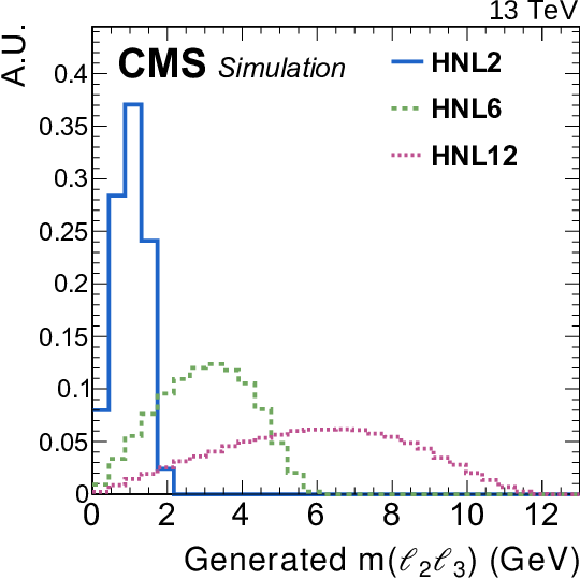
png pdf |
Figure 2-b:
Distribution of the $m({\ell _2} {\ell _3})$ variable for simulated HNL signal events. Predictions are shown for several benchmark hypotheses for Majorana HNL production: ${m_\mathrm{N}} =$ 2 GeV and $ {{| {V_{\mathrm{N} \ell}} |}^2} = $ 1.2$\times$10$^{-4}$ (HNL2), ${m_\mathrm{N}} =$ 6 GeV and $ {{| {V_{\mathrm{N} \ell}} |}^2} = $ 4.1$\times$10$^{-6}$ (HNL6), ${m_\mathrm{N}} =$ 12 GeV and $ {{| {V_{\mathrm{N} \ell}} |}^2} = $ 1.0$\times$10$^{-5}$ (HNL12). |
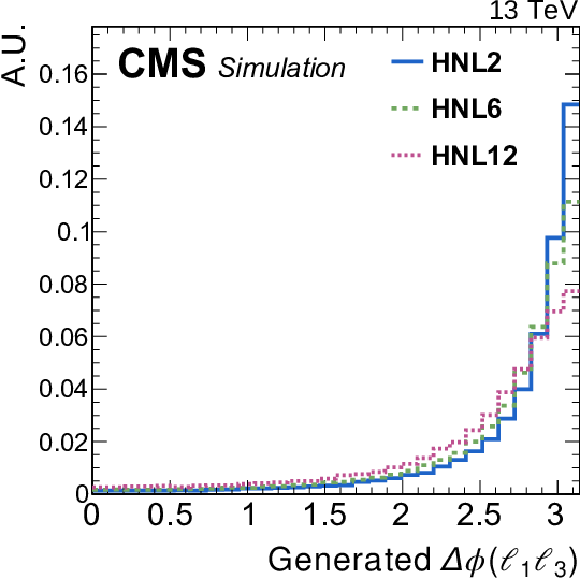
png pdf |
Figure 2-c:
Distribution of the angular separation between ${\ell _1}$ and ${\ell _3}$ for simulated HNL signal events. Predictions are shown for several benchmark hypotheses for Majorana HNL production: ${m_\mathrm{N}} =$ 2 GeV and $ {{| {V_{\mathrm{N} \ell}} |}^2} = $ 1.2$\times$10$^{-4}$ (HNL2), ${m_\mathrm{N}} =$ 6 GeV and $ {{| {V_{\mathrm{N} \ell}} |}^2} = $ 4.1$\times$10$^{-6}$ (HNL6), ${m_\mathrm{N}} =$ 12 GeV and $ {{| {V_{\mathrm{N} \ell}} |}^2} = $ 1.0$\times$10$^{-5}$ (HNL12). |
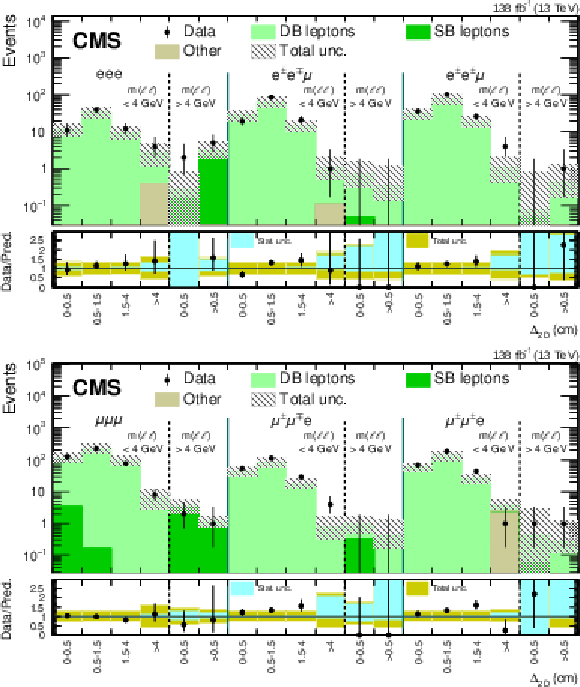
png pdf |
Figure 3:
Comparison between the number of observed events in data and the background predictions (shaded histograms, stacked) in the control regions for eeX (upper) and $ \mu \mu $X (lower) final states. The hashed band indicates the total systematic and statistical uncertainty in the background prediction. The lower panels indicate the ratio between data and prediction, and missing points indicate that the ratio lies outside the axis range. The uncertainty band assigned to the background prediction includes statistical and systematic contributions. Small contributions from background processes that are estimated from simulation are collectively referred to as "Other''. |

png pdf |
Figure 3-a:
Comparison between the number of observed events in data and the background predictions (shaded histograms, stacked) in the control regions for the eeX final state. The hashed band indicates the total systematic and statistical uncertainty in the background prediction. The lower panel indicates the ratio between data and prediction, and missing points indicate that the ratio lies outside the axis range. The uncertainty band assigned to the background prediction includes statistical and systematic contributions. Small contributions from background processes that are estimated from simulation are collectively referred to as "Other''. |
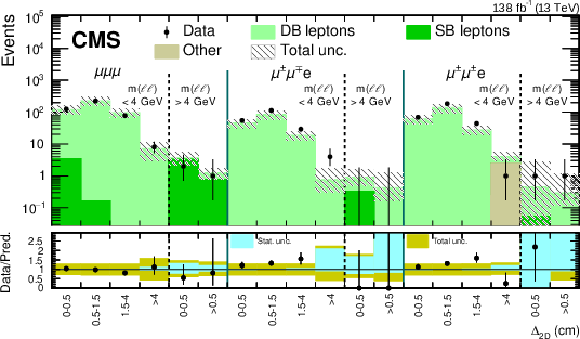
png pdf |
Figure 3-b:
Comparison between the number of observed events in data and the background predictions (shaded histograms, stacked) in the control regions for the $ \mu \mu $X final state. The hashed band indicates the total systematic and statistical uncertainty in the background prediction. The lower panel indicates the ratio between data and prediction, and missing points indicate that the ratio lies outside the axis range. The uncertainty band assigned to the background prediction includes statistical and systematic contributions. Small contributions from background processes that are estimated from simulation are collectively referred to as "Other''. |
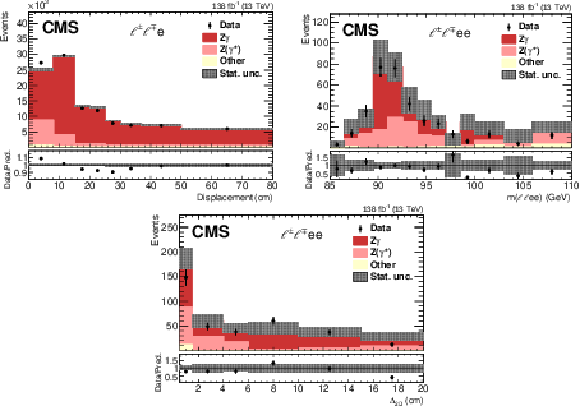
png pdf |
Figure 4:
Comparison between the observed number of events in data and simulation for converted photons. Events are selected in the final states with three (upper left) or four (upper right, lower) leptons, with one (or two) of the leptons identified as displaced electron(s). The distributions are shown for the displaced electron displacement $d$ (upper left) and reconstructed invariant mass of four leptons (upper right). Additionally, the ${\Delta _{\text {2D}}}$ variable is presented (lower). The simulated events correspond to the processes with external conversions, ${\mathrm{Z} \gamma ^{(*)}}$; internally converted photons, $\mathrm{Z} (\gamma ^{*})$; and other processes with the production of vector bosons and top quarks. The hashed band represents the statistical uncertainty in the simulation. The lower panels indicate the ratio between data and prediction. |
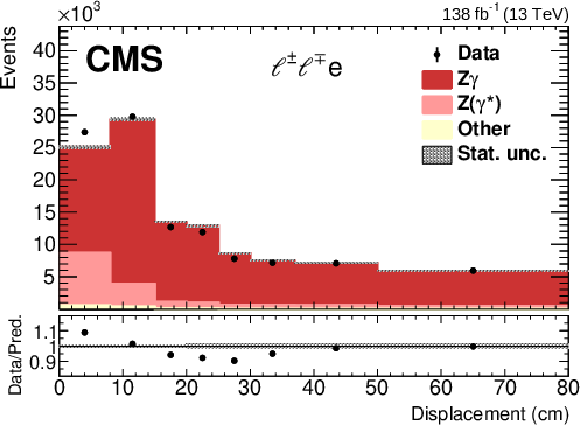
png pdf |
Figure 4-a:
Comparison between the observed number of events in data and simulation for converted photons. Events are selected in the final states with three leptons, with one (or two) of the leptons identified as displaced electron(s). The distribution of the displaced electron displacement $d$ is presented. The simulated events correspond to the processes with external conversions, ${\mathrm{Z} \gamma ^{(*)}}$; internally converted photons, $\mathrm{Z} (\gamma ^{*})$; and other processes with the production of vector bosons and top quarks. The hashed band represents the statistical uncertainty in the simulation. The lower panel indicates the ratio between data and prediction. |
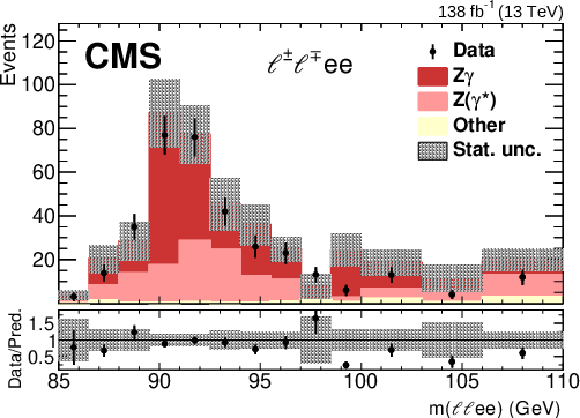
png pdf |
Figure 4-b:
Comparison between the observed number of events in data and simulation for converted photons. Events are selected in the final states with four leptons, with one (or two) of the leptons identified as displaced electron(s). The distribution of the reconstructed invariant mass of four leptons is presented. The simulated events correspond to the processes with external conversions, ${\mathrm{Z} \gamma ^{(*)}}$; internally converted photons, $\mathrm{Z} (\gamma ^{*})$; and other processes with the production of vector bosons and top quarks. The hashed band represents the statistical uncertainty in the simulation. The lower panel indicates the ratio between data and prediction. |
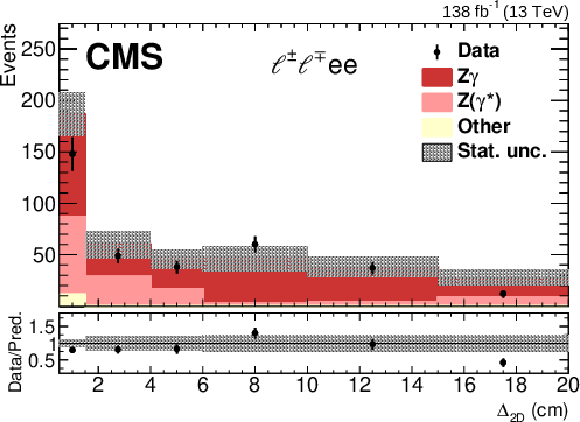
png pdf |
Figure 4-c:
Comparison between the observed number of events in data and simulation for converted photons. Events are selected in the final states with four leptons, with one (or two) of the leptons identified as displaced electron(s). The distribution of the ${\Delta _{\text {2D}}}$ variable is presented. The simulated events correspond to the processes with external conversions, ${\mathrm{Z} \gamma ^{(*)}}$; internally converted photons, $\mathrm{Z} (\gamma ^{*})$; and other processes with the production of vector bosons and top quarks. The hashed band represents the statistical uncertainty in the simulation. The lower panel indicates the ratio between data and prediction. |
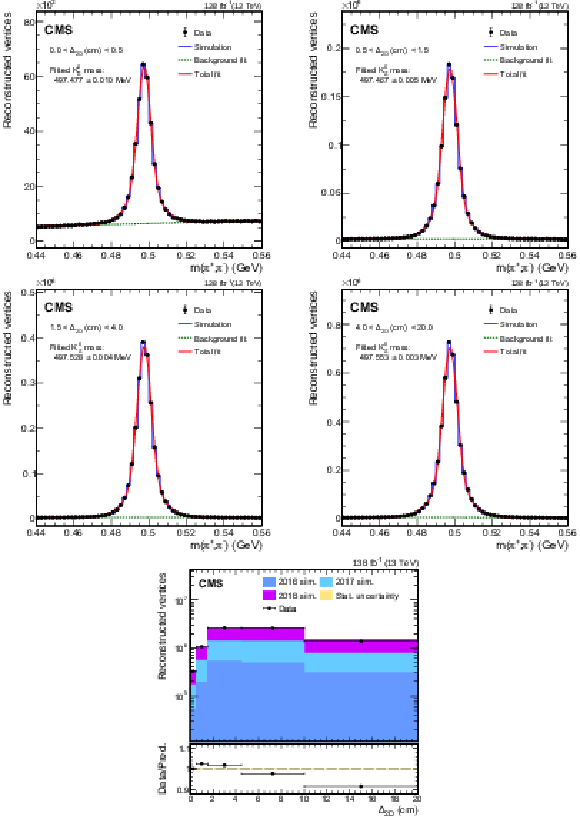
png pdf |
Figure 5:
The invariant mass distribution of the $\mathrm{K^0_S}$ candidates reconstructed using the $\pi^{\pm} \pi^{\mp}$ tracks for various displacement regions. The fitted $\mathrm{K^0_S}$ candidate mass in data in each region is also shown. The lowermost plot shows the $\mathrm{K^0_S}$ candidate yield after subtracting the background in data and in simulation, as well as their ratio, as a function of radial distance of the $\mathrm{K^0_S}$ vertex to the PV. The simulated yields are scaled to match the data in the lowest displacement bin. |

png pdf |
Figure 5-a:
The invariant mass distribution of the $\mathrm{K^0_S}$ candidates reconstructed using the $\pi^{\pm} \pi^{\mp}$ tracks for 0 $< {\Delta _{\text {2D}}} <$ 0.5. The fitted $\mathrm{K^0_S}$ candidate mass in data in each region is also shown. |

png pdf |
Figure 5-b:
The invariant mass distribution of the $\mathrm{K^0_S}$ candidates reconstructed using the $\pi^{\pm} \pi^{\mp}$ tracks for 0.5 $< {\Delta _{\text {2D}}} <$ 1.5. The fitted $\mathrm{K^0_S}$ candidate mass in data in each region is also shown. |

png pdf |
Figure 5-c:
The invariant mass distribution of the $\mathrm{K^0_S}$ candidates reconstructed using the $\pi^{\pm} \pi^{\mp}$ tracks for 1.5 $< {\Delta _{\text {2D}}} <$ 4.0. The fitted $\mathrm{K^0_S}$ candidate mass in data in each region is also shown. |

png pdf |
Figure 5-d:
The invariant mass distribution of the $\mathrm{K^0_S}$ candidates reconstructed using the $\pi^{\pm} \pi^{\mp}$ tracks for 4.0 $< {\Delta _{\text {2D}}} <$ 20.0. The fitted $\mathrm{K^0_S}$ candidate mass in data in each region is also shown. |

png pdf |
Figure 5-e:
The plot shows the $\mathrm{K^0_S}$ candidate yield after subtracting the background in data and in simulation, as well as their ratio, as a function of radial distance of the $\mathrm{K^0_S}$ vertex to the PV. The simulated yields are scaled to match the data in the lowest displacement bin. |

png pdf |
Figure 6:
Comparison between the number of observed events in data and the background predictions (shaded histograms, stacked) for the ${\Delta _{\text {2D}}}$ variable in eeX (left) and $ \mu \mu $X (right) final states. Events in the overflow bin are included in the last bin. The hashed band indicates the total systematic and statistical uncertainty in the background prediction. The lower panels indicate the ratio between data and prediction. Predictions for signal events are shown for several benchmark hypotheses for Majorana HNL production: ${m_\mathrm{N}} =$ 2 GeV and ${{| {V_{\mathrm{N} \ell}} |}^2} = $ 0.8$\times$10$^{-4}$ (HNL2), ${m_\mathrm{N}} =$ 6 GeV and ${{| {V_{\mathrm{N} \ell}} |}^2} = $ 1.3$\times$10$^{-6}$ (HNL6), ${m_\mathrm{N}} =$ 12 GeV and ${{| {V_{\mathrm{N} \ell}} |}^2} = $ 1.0$\times$10$^{-6}$ (HNL12). |

png pdf |
Figure 6-a:
Comparison between the number of observed events in data and the background predictions (shaded histograms, stacked) for the ${\Delta _{\text {2D}}}$ variable in the eeX final state. Events in the overflow bin are included in the last bin. The hashed band indicates the total systematic and statistical uncertainty in the background prediction. The lower panels indicate the ratio between data and prediction. Predictions for signal events are shown for several benchmark hypotheses for Majorana HNL production: ${m_\mathrm{N}} =$ 2 GeV and ${{| {V_{\mathrm{N} \ell}} |}^2} = $ 0.8$\times$10$^{-4}$ (HNL2), ${m_\mathrm{N}} =$ 6 GeV and ${{| {V_{\mathrm{N} \ell}} |}^2} = $ 1.3$\times$10$^{-6}$ (HNL6), ${m_\mathrm{N}} =$ 12 GeV and ${{| {V_{\mathrm{N} \ell}} |}^2} = $ 1.0$\times$10$^{-6}$ (HNL12). |
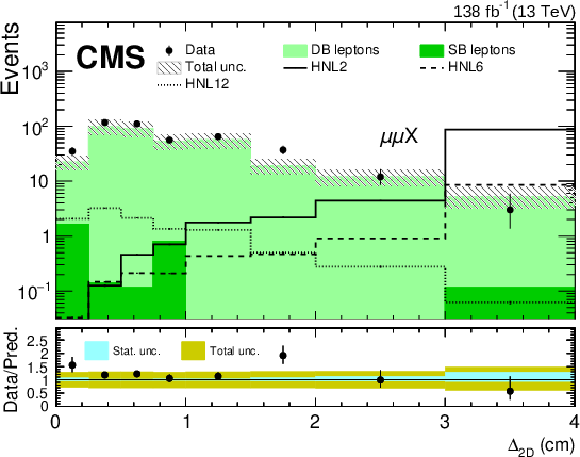
png pdf |
Figure 6-b:
Comparison between the number of observed events in data and the background predictions (shaded histograms, stacked) for the ${\Delta _{\text {2D}}}$ variable in the $ \mu \mu $X final state. Events in the overflow bin are included in the last bin. The hashed band indicates the total systematic and statistical uncertainty in the background prediction. The lower panels indicate the ratio between data and prediction. Predictions for signal events are shown for several benchmark hypotheses for Majorana HNL production: ${m_\mathrm{N}} =$ 2 GeV and ${{| {V_{\mathrm{N} \ell}} |}^2} = $ 0.8$\times$10$^{-4}$ (HNL2), ${m_\mathrm{N}} =$ 6 GeV and ${{| {V_{\mathrm{N} \ell}} |}^2} = $ 1.3$\times$10$^{-6}$ (HNL6), ${m_\mathrm{N}} =$ 12 GeV and ${{| {V_{\mathrm{N} \ell}} |}^2} = $ 1.0$\times$10$^{-6}$ (HNL12). |
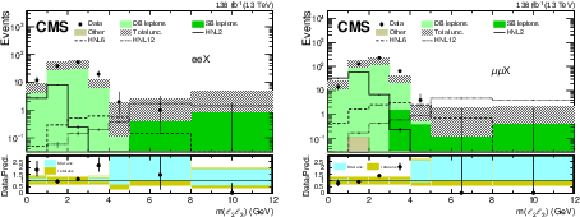
png pdf |
Figure 7:
Comparison between the number of observed events in data and the background predictions (shaded histograms, stacked) for the $m({\ell _2} {\ell _3})$ variable in eeX (left) and $ \mu \mu $X (right) final states. Events in the overflow bin are included in the last bin. The hashed band indicates the total systematic and statistical uncertainty in the background prediction. The lower panels indicate the ratio between data and prediction, and missing points indicate that the ratio lies outside the axis range. Predictions for signal events are shown for several benchmark hypotheses for Majorana HNL production: ${m_\mathrm{N}} =$ 2 GeV and ${{| {V_{\mathrm{N} \ell}} |}^2} = $ 0.8$\times$10$^{-4}$ (HNL2), ${m_\mathrm{N}} =$ 6 GeV and ${{| {V_{\mathrm{N} \ell}} |}^2} = $ 1.3$\times$10$^{-6}$ (HNL6), ${m_\mathrm{N}} =$ 12 GeV and ${{| {V_{\mathrm{N} \ell}} |}^2} = $ 1.0$\times$10$^{-6}$ (HNL12). Small contributions from background processes that are estimated from simulation are collectively referred to as "Other''. |
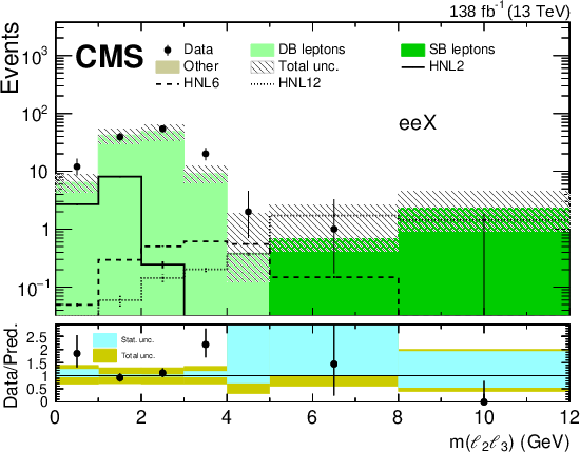
png pdf |
Figure 7-a:
Comparison between the number of observed events in data and the background predictions (shaded histograms, stacked) for the $m({\ell _2} {\ell _3})$ variable in the eeX final state. Events in the overflow bin are included in the last bin. The hashed band indicates the total systematic and statistical uncertainty in the background prediction. The lower panels indicate the ratio between data and prediction, and missing points indicate that the ratio lies outside the axis range. Predictions for signal events are shown for several benchmark hypotheses for Majorana HNL production: ${m_\mathrm{N}} =$ 2 GeV and ${{| {V_{\mathrm{N} \ell}} |}^2} = $ 0.8$\times$10$^{-4}$ (HNL2), ${m_\mathrm{N}} =$ 6 GeV and ${{| {V_{\mathrm{N} \ell}} |}^2} = $ 1.3$\times$10$^{-6}$ (HNL6), ${m_\mathrm{N}} =$ 12 GeV and ${{| {V_{\mathrm{N} \ell}} |}^2} = $ 1.0$\times$10$^{-6}$ (HNL12). Small contributions from background processes that are estimated from simulation are collectively referred to as "Other''. |
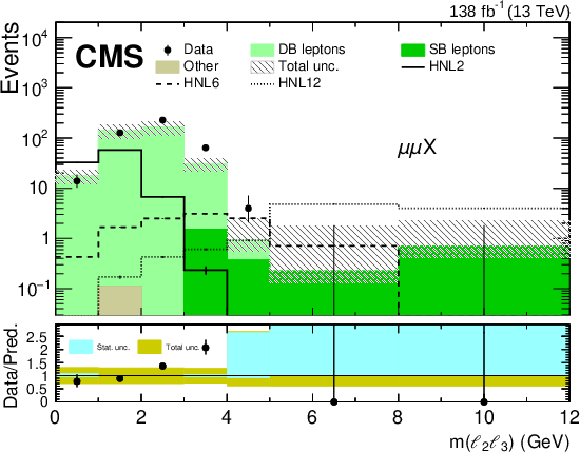
png pdf |
Figure 7-b:
Comparison between the number of observed events in data and the background predictions (shaded histograms, stacked) for the $m({\ell _2} {\ell _3})$ variable in the $ \mu \mu $X final state. Events in the overflow bin are included in the last bin. The hashed band indicates the total systematic and statistical uncertainty in the background prediction. The lower panels indicate the ratio between data and prediction, and missing points indicate that the ratio lies outside the axis range. Predictions for signal events are shown for several benchmark hypotheses for Majorana HNL production: ${m_\mathrm{N}} =$ 2 GeV and ${{| {V_{\mathrm{N} \ell}} |}^2} = $ 0.8$\times$10$^{-4}$ (HNL2), ${m_\mathrm{N}} =$ 6 GeV and ${{| {V_{\mathrm{N} \ell}} |}^2} = $ 1.3$\times$10$^{-6}$ (HNL6), ${m_\mathrm{N}} =$ 12 GeV and ${{| {V_{\mathrm{N} \ell}} |}^2} = $ 1.0$\times$10$^{-6}$ (HNL12). Small contributions from background processes that are estimated from simulation are collectively referred to as "Other''. |

png pdf |
Figure 8:
Comparison between the number of observed events in data and the background predictions (shaded histograms, stacked) in the search regions for eeX (upper) and $ \mu \mu $X (lower) final states. The hashed band indicates the total systematic and statistical uncertainty in the background prediction. The lower panels indicate the ratio between data and prediction, and missing points indicate that the ratio lies outside the axis range. Predictions for signal events are shown for several benchmark hypotheses for Majorana HNL production: ${m_\mathrm{N}} =$ 2 GeV and ${{| {V_{\mathrm{N} \ell}} |}^2} = $ 0.8$\times$10$^{-4}$ (HNL2), ${m_\mathrm{N}} =$ 6 GeV and ${{| {V_{\mathrm{N} \ell}} |}^2} = $ 1.3$\times$10$^{-6}$ (HNL6), ${m_\mathrm{N}} =$ 12 GeV and ${{| {V_{\mathrm{N} \ell}} |}^2} = $ 1.0$\times$10$^{-6}$ (HNL12). The uncertainty band assigned to the background prediction includes statistical and systematic contributions. Small contributions from background processes that are estimated from simulation are collectively referred to as "Other''. |

png pdf |
Figure 8-a:
Comparison between the number of observed events in data and the background predictions (shaded histograms, stacked) in the search regions for the eeX final states. The hashed band indicates the total systematic and statistical uncertainty in the background prediction. The lower panels indicate the ratio between data and prediction, and missing points indicate that the ratio lies outside the axis range. Predictions for signal events are shown for several benchmark hypotheses for Majorana HNL production: ${m_\mathrm{N}} =$ 2 GeV and ${{| {V_{\mathrm{N} \ell}} |}^2} = $ 0.8$\times$10$^{-4}$ (HNL2), ${m_\mathrm{N}} =$ 6 GeV and ${{| {V_{\mathrm{N} \ell}} |}^2} = $ 1.3$\times$10$^{-6}$ (HNL6), ${m_\mathrm{N}} =$ 12 GeV and ${{| {V_{\mathrm{N} \ell}} |}^2} = $ 1.0$\times$10$^{-6}$ (HNL12). The uncertainty band assigned to the background prediction includes statistical and systematic contributions. Small contributions from background processes that are estimated from simulation are collectively referred to as "Other''. |
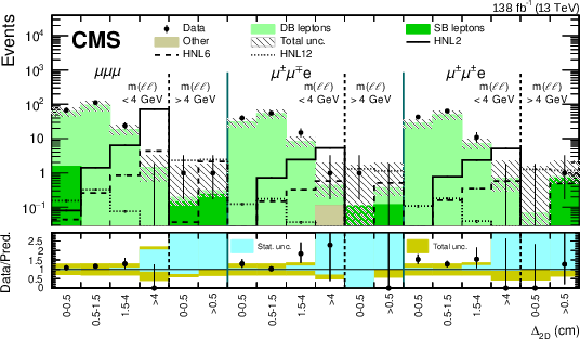
png pdf |
Figure 8-b:
Comparison between the number of observed events in data and the background predictions (shaded histograms, stacked) in the search regions for the $ \mu \mu $X final states. The hashed band indicates the total systematic and statistical uncertainty in the background prediction. The lower panels indicate the ratio between data and prediction, and missing points indicate that the ratio lies outside the axis range. Predictions for signal events are shown for several benchmark hypotheses for Majorana HNL production: ${m_\mathrm{N}} =$ 2 GeV and ${{| {V_{\mathrm{N} \ell}} |}^2} = $ 0.8$\times$10$^{-4}$ (HNL2), ${m_\mathrm{N}} =$ 6 GeV and ${{| {V_{\mathrm{N} \ell}} |}^2} = $ 1.3$\times$10$^{-6}$ (HNL6), ${m_\mathrm{N}} =$ 12 GeV and ${{| {V_{\mathrm{N} \ell}} |}^2} = $ 1.0$\times$10$^{-6}$ (HNL12). The uncertainty band assigned to the background prediction includes statistical and systematic contributions. Small contributions from background processes that are estimated from simulation are collectively referred to as "Other''. |

png pdf |
Figure 9:
The 95% CL limits on ${{| {V_{\mathrm{N} \mathrm{e}}} |}^2}$ (left) and ${{| {V_{\mathrm{N} \mu}} |}^2}$ (right) as functions of ${m_\mathrm{N}}$ for a Majorana HNL. The area inside the solid (dashed) black curve indicates the observed (expected) exclusion region. Results from the DELPHI [18] and the CMS [20,19] Collaborations are shown for reference. |

png pdf |
Figure 9-a:
The 95% CL limits on ${{| {V_{\mathrm{N} \mathrm{e}}} |}^2}$ as functions of ${m_\mathrm{N}}$ for a Majorana HNL. The area inside the solid (dashed) black curve indicates the observed (expected) exclusion region. Results from the DELPHI [18] and the CMS [20,19] Collaborations are shown for reference. |
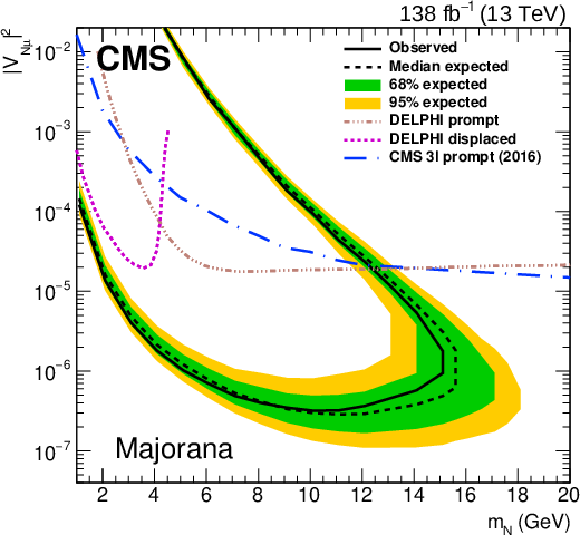
png pdf |
Figure 9-b:
The 95% CL limits on ${{| {V_{\mathrm{N} \mu}} |}^2}$ as functions of ${m_\mathrm{N}}$ for a Majorana HNL. The area inside the solid (dashed) black curve indicates the observed (expected) exclusion region. Results from the DELPHI [18] and the CMS [20,19] Collaborations are shown for reference. |
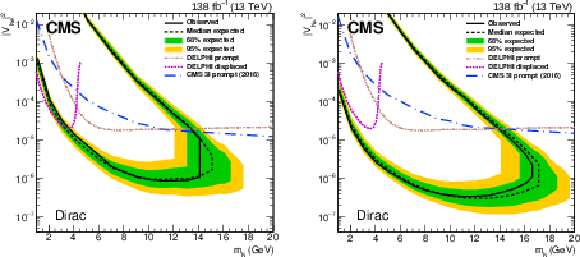
png pdf |
Figure 10:
The 95% CL limits on ${{| {V_{\mathrm{N} \mathrm{e}}} |}^2}$ (left) and ${{| {V_{\mathrm{N} \mu}} |}^2}$ (right) as functions of ${m_\mathrm{N}}$ for a Dirac HNL. The area inside the solid (dashed) black curve indicates the observed (expected) exclusion region. Results from the DELPHI [18] and the CMS [20,19] Collaborations are shown for reference. |

png pdf |
Figure 10-a:
The 95% CL limits on ${{| {V_{\mathrm{N} \mathrm{e}}} |}^2}$ as functions of ${m_\mathrm{N}}$ for a Dirac HNL. The area inside the solid (dashed) black curve indicates the observed (expected) exclusion region. Results from the DELPHI [18] and the CMS [20,19] Collaborations are shown for reference. |

png pdf |
Figure 10-b:
The 95% CL limits on ${{| {V_{\mathrm{N} \mu}} |}^2}$ as functions of ${m_\mathrm{N}}$ for a Dirac HNL. The area inside the solid (dashed) black curve indicates the observed (expected) exclusion region. Results from the DELPHI [18] and the CMS [20,19] Collaborations are shown for reference. |
| Tables | |
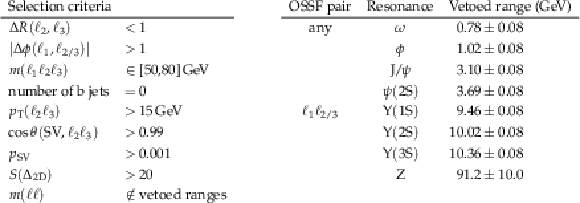
png pdf |
Table 1:
Baseline selection criteria (left) and dilepton invariant mass vetoes (right) applied in the analysis. The width of the vetoed range for the meson resonances reflects the experimental resolution of the dilepton invariant mass reconstruction. |

png pdf |
Table 2:
Definition of kinematic regions in terms of dilepton invariant mass $m({\ell _2} {\ell _3})$ and SV displacement ${\Delta _{\text {2D}}}$. |

png pdf |
Table 3:
Number of predicted and observed events in the eeX final states. The quoted uncertainties include statistical and systematic components. |

png pdf |
Table 4:
Number of predicted and observed events in the $ \mu \mu $X final states. The quoted uncertainties include statistical and systematic components. |

png pdf |
Table 5:
Number of predicted signal events in the eeX final states. The results are presented for several benchmark signal hypotheses for Majorana HNL production: ${m_\mathrm{N}} =$ 2 GeV and ${{| {V_{\mathrm{N} \ell}} |}^2} = $ 0.8$\times$10$^{-4}$ (HNL2), ${m_\mathrm{N}} =$ 6 GeV and ${{| {V_{\mathrm{N} \ell}} |}^2} = $ 1.3$\times$10$^{-6}$ (HNL6), ${m_\mathrm{N}} =$ 12 GeV and ${{| {V_{\mathrm{N} \ell}} |}^2} = $ 1.0$\times$10$^{-6}$ (HNL12). The quoted uncertainties include statistical and systematic components. |

png pdf |
Table 6:
Number of predicted signal events in the $ \mu \mu $X final states. The results are presented for several benchmark signal hypotheses for Majorana HNL production: ${m_\mathrm{N}} =$ 2 GeV and ${{| {V_{\mathrm{N} \ell}} |}^2} = $ 0.8$\times$10$^{-4}$ (HNL2), ${m_\mathrm{N}} =$ 6 GeV and ${{| {V_{\mathrm{N} \ell}} |}^2} = $ 1.3$\times$10$^{-6}$ (HNL6), ${m_\mathrm{N}} =$ 12 GeV and ${{| {V_{\mathrm{N} \ell}} |}^2} = $ 1.0$\times$10$^{-6}$ (HNL12). The quoted uncertainties include statistical and systematic components. |
| Summary |
|
A search for heavy neutral leptons (HNLs) has been performed in the decays of W bosons produced in proton-proton collisions at $\sqrt{s} = $ 13 TeV and collected by the CMS experiment at the LHC. The analysis uses a data set corresponding to an integrated luminosity of 138 fb$^{-1}$. Events with three charged leptons are selected, and dedicated methods are applied to identify two displaced leptons consistent with the decay of a long-lived HNL in the mass range 1-20 GeV. Novel methods have been developed to estimate relevant background contributions from control samples in data, addressing one of the important challenges in this type of search at the LHC. No significant deviation from the standard model predictions is observed. Exclusion limits are evaluated at 95% confidence level on the coupling strengths of HNLs to standard model neutrinos as functions of the HNL mass, covering HNL masses from 1 up to 16.5 GeV and squared mixing parameters as low as 3.2$\times$10$^{-7}$, depending on the scenario. These results exceed previous experimental constraints in the mass range 3-14 (1-16.5) GeV for HNLs coupling to electrons (muons) and provide the most stringent limits to date. |
| Additional Figures | |

png pdf |
Additional Figure 1:
Covariance matrix for the background prediction in the signal region bins for the eeX (a) and $ {\mu} {\mu} $X (b) final states. The bin labels specify the channel, the $m(\ell_2,\ell_3)$ bin in GeV, and the $\Delta _{\text {2D}}$ bin in cm. |

png pdf |
Additional Figure 1-a:
Covariance matrix for the background prediction in the signal region bins for the eeX final state. The bin labels specify the channel, the $m(\ell_2,\ell_3)$ bin in GeV, and the $\Delta _{\text {2D}}$ bin in cm. |
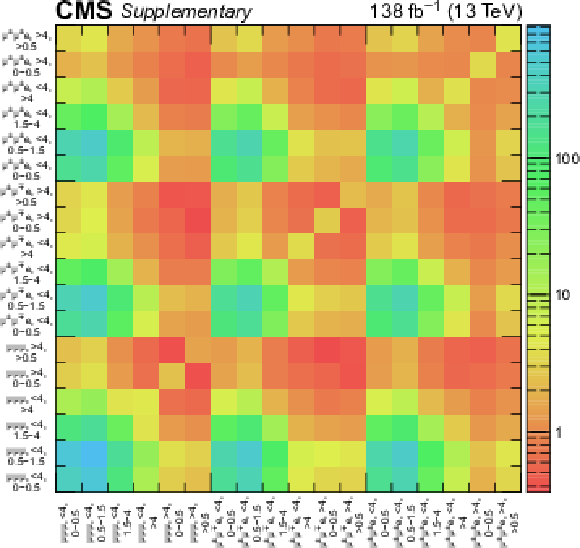
png pdf |
Additional Figure 1-b:
Covariance matrix for the background prediction in the signal region bins for the $ {\mu} {\mu} $X final state. The bin labels specify the channel, the $m(\ell_2,\ell_3)$ bin in GeV, and the $\Delta _{\text {2D}}$ bin in cm. |

png pdf |
Additional Figure 2:
Correlation matrix obtained from the covariance matrix for the background prediction in the signal region bins for the eeX (a) and $ {\mu} {\mu} $X (b) final states. The coefficients are obtained from the background-only fit. The bin labels specify the channel, the $m(\ell_2,\ell_3)$ bin in GeV, and the $\Delta _{\text {2D}}$ bin in cm. |
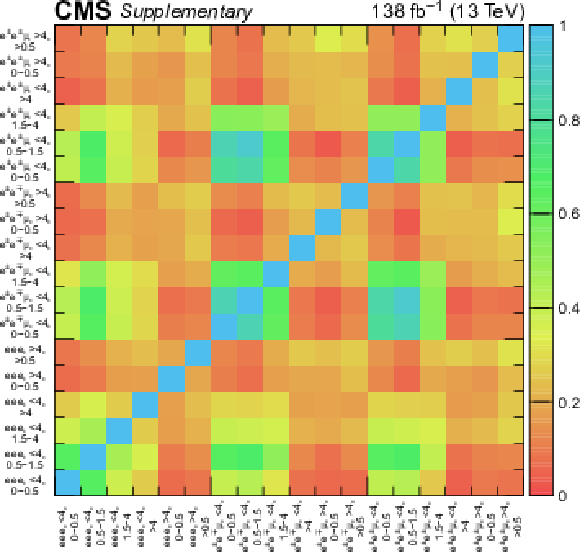
png pdf |
Additional Figure 2-a:
Correlation matrix obtained from the covariance matrix for the background prediction in the signal region bins for the eeX final state. The coefficients are obtained from the background-only fit. The bin labels specify the channel, the $m(\ell_2,\ell_3)$ bin in GeV, and the $\Delta _{\text {2D}}$ bin in cm. |

png pdf |
Additional Figure 2-b:
Correlation matrix obtained from the covariance matrix for the background prediction in the signal region bins for the $ {\mu} {\mu} $X final state. The coefficients are obtained from the background-only fit. The bin labels specify the channel, the $m(\ell_2,\ell_3)$ bin in GeV, and the $\Delta _{\text {2D}}$ bin in cm. |
| Additional Tables | |

png pdf |
Additional Table 1:
Number of predicted signal events in the eeX final states. The results are presented for several benchmark signal hypotheses for Majorana HNL production: $m_{\mathrm {N}} = $ 4 GeV and $ {| V_{\mathrm {N}} |}^2=$ 0.8$\times$10$^{-4}$ (HNL4), $m_{\mathrm {N}} = $ 8 GeV and $ {| V_{\mathrm {N}} |}^2=$ 1.3$\times$10$^{-6}$ (HNL8), $m_{\mathrm {N}} = $ 10 GeV and $ {| V_{\mathrm {N}} |}^2=$ 1.0$\times$10$^{-6}$ (HNL10). The quoted uncertainties include statistical and systematic components. |
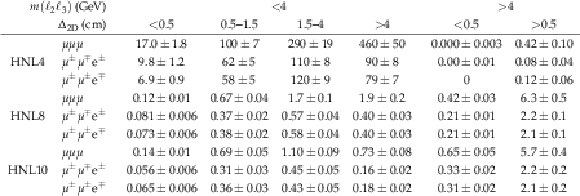
png pdf |
Additional Table 2:
Number of predicted signal events in the $ {\mu} {\mu} $X final states. The results are presented for several benchmark signal hypotheses for Majorana HNL production: $m_{\mathrm {N}} = $ 4 GeV and $ {| V_{\mathrm {N}} |}^2=$ 0.8$\times$10$^{-4}$ (HNL4), $m_{\mathrm {N}} = $ 8 GeV and $ {| V_{\mathrm {N}} |}^2=$ 1.3$\times$10$^{-6}$ (HNL8), $m_{\mathrm {N}} = $ 10 GeV and $ {| V_{\mathrm {N}} |}^2=$ 1.0$\times$10$^{-6}$ (HNL10). The quoted uncertainties include statistical and systematic components. |

png pdf |
Additional Table 3:
Mean lifetime and production cross section for HNLs of Majorana nature, for different masses and coupling strengths, assuming the decay to three charged leptons and coupling to only electrons or muons, as evaluated from simulated event samples. |
| References | ||||
| 1 | Super-Kamiokande Collaboration | Evidence for oscillation of atmospheric neutrinos | PRL 81 (1998) 1562 | hep-ex/9807003 |
| 2 | SNO Collaboration | Direct evidence for neutrino flavor transformation from neutral-current interactions in the Sudbury Neutrino Observatory | PRL 89 (2002) 011301 | nucl-ex/0204008 |
| 3 | KamLAND Collaboration | First results from KamLAND: Evidence for reactor antineutrino disappearance | PRL 90 (2003) 021802 | hep-ex/0212021 |
| 4 | S. Bilenky | Neutrino oscillations: From a historical perspective to the present status | NPB 908 (2016) 2 | 1602.00170 |
| 5 | S. Roy Choudhury and S. Hannestad | Updated results on neutrino mass and mass hierarchy from cosmology with Planck 2018 likelihoods | JCAP 07 (2020) 037 | 1907.12598 |
| 6 | M. Ivanov, M. Simonović, and M. Zaldarriaga | Cosmological parameters and neutrino masses from the final Planck and full-shape BOSS data | PRD 101 (2020) 083504 | 1912.08208 |
| 7 | J. Formaggio, A. de Gouvêa, and R. Robertson | Direct measurements of neutrino mass | PR 914 (2021) 1 | 2102.00594 |
| 8 | P. Minkowski | $ {\mu\to\mathrm{e}\gamma} $ at a rate of one out of 10$^{9}$ muon decays? | PLB 67 (1977) 421 | |
| 9 | T. Yanagida | Horizontal gauge symmetry and masses of neutrinos | in Proc. Workshop on the Unified Theories and the Baryon Number in the Universe: Tsukuba, Japan, 1979 | |
| 10 | M. Gell-Mann, P. Ramond, and R. Slansky | Complex spinors and unified theories | in Supergravity, North Holland Publishing | 1306.4669 |
| 11 | S. Glashow | The future of elementary particle physics | NATO Sci. Ser. B 61 (1980) 687 | |
| 12 | R. Mohapatra and G. Senjanović | Neutrino mass and spontaneous parity nonconservation | PRL 44 (1980) 912 | |
| 13 | J. Schechter and J. Valle | Neutrino masses in SU(2)$\otimes$U(1) theories | PRD 22 (1980) 2227 | |
| 14 | R. Shrock | General theory of weak leptonic and semileptonic decays. I. leptonic pseudoscalar meson decays, with associated tests for, and bounds on, neutrino masses and lepton mixing | PRD 24 (1981) 1232 | |
| 15 | Y. Cai, T. Han, T. Li, and R. Ruiz | Lepton number violation: Seesaw models and their collider tests | Front. in Phys. 6 (2018) 40 | 1711.02180 |
| 16 | Z. Maki, M. Nakagawa, and S. Sakata | Remarks on the unified model of elementary particles | Prog. Theor. Phys. 28 (1962) 870 | |
| 17 | B. Pontecorvo | Neutrino experiments and the problem of conservation of leptonic charge | Zh. Eksp. Teor. Fiz. 53 (1967) 1717 | |
| 18 | Particle Data Group, P. A. Zyla et al. | Review of particle physics | Prog. Theor. Exp. Phys. 2020 (2020) 083C01 | |
| 19 | S. Dodelson and L. Widrow | Sterile neutrinos as dark matter | PRL 72 (1994) 17 | hep-ph/9303287 |
| 20 | A. Boyarsky et al. | Sterile neutrino dark matter | Prog. Part. NP 104 (2019) 1 | 1807.07938 |
| 21 | M. Fukugita and T. Yanagida | Baryogenesis without grand unification | PLB 174 (1986) 45 | |
| 22 | E. Chun et al. | Probing leptogenesis | Int. J. Mod. Phys. A 33 (2018) 1842005 | 1711.02865 |
| 23 | F. Deppisch, P. Bhupal Dev, and A. Pilaftsis | Neutrinos and collider physics | New J. Phys. 17 (2015) 075019 | 1502.06541 |
| 24 | DELPHI Collaboration | Search for neutral heavy leptons produced in Z decays | Z. Phys. C 74 (1997) 57 | |
| 25 | CMS Collaboration | Search for heavy Majorana neutrinos in $ {\mu^{\pm}\mu^{\pm}} $+jets and $ {\mathrm{e^{\pm}}\mathrm{e^{\pm}}} $+jets events in pp collisions at $ \sqrt{s} = $ 7 TeV | PLB 717 (2012) 109 | CMS-EXO-11-076 1207.6079 |
| 26 | CMS Collaboration | Search for heavy Majorana neutrinos in $ {\mu^{\pm}\mu^{\pm}} $+jets events in proton-proton collisions at $ \sqrt{s} = $ 8 TeV | PLB 748 (2015) 144 | CMS-EXO-12-057 1501.05566 |
| 27 | ATLAS Collaboration | Search for heavy Majorana neutrinos with the ATLAS detector in pp collisions at $ \sqrt{s} = $ 8 TeV | JHEP 07 (2015) 162 | 1506.06020 |
| 28 | CMS Collaboration | Search for heavy Majorana neutrinos in $ {\mathrm{e^{\pm}}\mathrm{e^{\pm}}} $+jets and $ {\mathrm{e^{\pm}}\mu^{\pm}} $+jets events in proton-proton collisions at $ \sqrt{s} = $ 8 TeV | JHEP 04 (2016) 169 | CMS-EXO-14-014 1603.02248 |
| 29 | CMS Collaboration | Search for heavy neutral leptons in events with three charged leptons in proton-proton collisions at $ \sqrt{s} = $ 13 TeV | PRL 120 (2018) 221801 | CMS-EXO-17-012 1802.02965 |
| 30 | CMS Collaboration | Search for heavy Majorana neutrinos in same-sign dilepton channels in proton-proton collisions at $ \sqrt{s} = $ 13 TeV | JHEP 01 (2019) 122 | CMS-EXO-17-028 1806.10905 |
| 31 | ATLAS Collaboration | Search for heavy neutral leptons in decays of $ \mathrm{W} bosons $ produced in 13 $ TeV pp $ collisions using prompt and displaced signatures with the ATLAS detector | JHEP 10 (2019) 265 | 1905.09787 |
| 32 | LHCb Collaboration | Search for heavy neutral leptons in $ {\mathrm{W^{+}}\to\mu^{+}\mu^{\pm} \text{jet}} $ decays | EPJC 81 (2021) 248 | 2011.05263 |
| 33 | T. Asaka, S. Blanchet, and M. Shaposhnikov | The $\nu$MSM, dark matter and neutrino masses | PLB 631 (2005) 151 | hep-ph/0503065 |
| 34 | M. Drewes, Y. Georis, and J. Klarić | Mapping the viable parameter space for testable leptogenesis | PRL 128 (2022) 051801 | 2106.16226 |
| 35 | A. Abada, N. Bernal, M. Losada, and X. Marcano | Inclusive displaced vertex searches for heavy neutral leptons at the LHC | JHEP 01 (2019) 093 | 1807.10024 |
| 36 | J.-L. Tastet, O. Ruchayskiy, and I. Timiryasov | Reinterpreting the ATLAS bounds on heavy neutral leptons in a realistic neutrino oscillation model | JHEP 12 (2021) 182 | 2107.12980 |
| 37 | I. Boiarska, A. Boyarsky, O. Mikulenko, and M. Ovchynnikov | Constraints from the CHARM experiment on heavy neutral leptons with tau mixing | PRD 104 (2021) 095019 | 2107.14685 |
| 38 | C. Degrande, O. Mattelaer, R. Ruiz, and J. Turner | Fully automated precision predictions for heavy neutrino production mechanisms at hadron colliders | PRD 94 (2016) 053002 | 1602.06957 |
| 39 | A. Das, P. Konar, and S. Majhi | Production of heavy neutrino in next-to-leading order QCD at the LHC and beyond | JHEP 06 (2016) 019 | 1604.00608 |
| 40 | CMS Collaboration | HEPData record for this analysis | link | |
| 41 | CMS Collaboration | The CMS experiment at the CERN LHC | JINST 3 (2008) S08004 | CMS-00-001 |
| 42 | CMS Collaboration | Performance of the CMS Level-1 trigger in proton-proton collisions at $ \sqrt{s} = $ 13 TeV | JINST 15 (2020) P10017 | CMS-TRG-17-001 2006.10165 |
| 43 | CMS Collaboration | The CMS trigger system | JINST 12 (2017) P01020 | CMS-TRG-12-001 1609.02366 |
| 44 | CMS Collaboration | Description and performance of track and primary-vertex reconstruction with the CMS tracker | JINST 9 (2014) P10009 | CMS-TRK-11-001 1405.6569 |
| 45 | CMS Collaboration | 2017 tracking performance plots | CDS | |
| 46 | CMS Tracker Group, W. Adam et al. | The CMS Phase-1 pixel detector upgrade | JINST 16 (2021) P02027 | 2012.14304 |
| 47 | CMS Collaboration | Track impact parameter resolution for the full pseudo rapidity coverage in the 2017 dataset with the CMS Phase-1 pixel detector | CDS | |
| 48 | M. Cacciari, G. Salam, and G. Soyez | The anti-$ {k_{\mathrm{T}}} $ jet clustering algorithm | JHEP 04 (2008) 063 | 0802.1189 |
| 49 | M. Cacciari, G. Salam, and G. Soyez | FastJet user manual | EPJC 72 (2012) 1896 | 1111.6097 |
| 50 | CMS Collaboration | Particle-flow reconstruction and global event description with the CMS detector | JINST 12 (2017) P10003 | CMS-PRF-14-001 1706.04965 |
| 51 | CMS Collaboration | Electron and photon reconstruction and identification with the CMS experiment at the CERN LHC | JINST 16 (2021) P05014 | CMS-EGM-17-001 2012.06888 |
| 52 | CMS Collaboration | Performance of the CMS muon detector and muon reconstruction with proton-proton collisions at $ \sqrt{s} = $ 13 TeV | JINST 13 (2018) P06015 | CMS-MUO-16-001 1804.04528 |
| 53 | CMS Collaboration | Performance of missing transverse momentum reconstruction in proton-proton collisions at $ \sqrt{s} = $ 13 TeV using the CMS detector | JINST 14 (2019) P07004 | CMS-JME-17-001 1903.06078 |
| 54 | CMS Collaboration | Measurement of the inelastic proton-proton cross section at $ \sqrt{s} = $ 13 TeV | JHEP 07 (2018) 161 | CMS-FSQ-15-005 1802.02613 |
| 55 | GEANT4 Collaboration | GEANT4--a simulation toolkit | NIMA 506 (2003) 250 | |
| 56 | J. Alwall et al. | The automated computation of tree-level and next-to-leading order differential cross sections, and their matching to parton shower simulations | JHEP 07 (2014) 079 | 1405.0301 |
| 57 | P. Artoisenet, R. Frederix, O. Mattelaer, and R. Rietkerk | Automatic spin-entangled decays of heavy resonances in Monte Carlo simulations | JHEP 03 (2013) 015 | 1212.3460 |
| 58 | A. Atre, T. Han, S. Pascoli, and B. Zhang | The search for heavy Majorana neutrinos | JHEP 05 (2009) 030 | 0901.3589 |
| 59 | D. Alva, T. Han, and R. Ruiz | Heavy Majorana neutrinos from W$ \gamma $ fusion at hadron colliders | JHEP 02 (2015) 072 | 1411.7305 |
| 60 | S. Pascoli, R. Ruiz, and C. Weiland | Heavy neutrinos with dynamic jet vetoes: multilepton searches at $ \sqrt{s}= $ 14 , 27, and 100 TeV | JHEP 06 (2019) 049 | 1812.08750 |
| 61 | K. Melnikov and F. Petriello | Electroweak gauge boson production at hadron colliders through $ \mathcal{O}({{\alpha_S}^2}) $ | PRD 74 (2006) 114017 | hep-ph/0609070 |
| 62 | R. Gavin, Y. Li, F. Petriello, and S. Quackenbush | FEWZ2.0: A code for hadronic Z production at next-to-next-to-leading order | CPC 182 (2011) 2388 | 1011.3540 |
| 63 | R. Gavin, Y. Li, F. Petriello, and S. Quackenbush | W physics at the LHC with FEWZ2.1 | CPC 184 (2013) 208 | 1201.5896 |
| 64 | Y. Li and F. Petriello | Combining QCD and electroweak corrections to dilepton production in FEWZ | PRD 86 (2012) 094034 | 1208.5967 |
| 65 | R. Frederix and S. Frixione | Merging meets matching in MCatNLO | JHEP 12 (2012) 061 | 1209.6215 |
| 66 | J. Alwall et al. | Comparative study of various algorithms for the merging of parton showers and matrix elements in hadronic collisions | EPJC 53 (2008) 473 | 0706.2569 |
| 67 | P. Nason | A new method for combining NLO QCD with shower Monte Carlo algorithms | JHEP 11 (2004) 040 | hep-ph/0409146 |
| 68 | S. Frixione, P. Nason, and G. Ridolfi | A positive-weight next-to-leading-order Monte Carlo for heavy flavour hadroproduction | JHEP 09 (2007) 126 | 0707.3088 |
| 69 | S. Frixione, P. Nason, and C. Oleari | Matching NLO QCD computations with parton shower simulations: the POWHEG method | JHEP 11 (2007) 070 | 0709.2092 |
| 70 | S. Alioli, P. Nason, C. Oleari, and E. Re | NLO single-top production matched with shower in POWHEG: $ s $- and $ t $-channel contributions | JHEP 09 (2009) 111 | 0907.4076 |
| 71 | S. Alioli, P. Nason, C. Oleari, and E. Re | A general framework for implementing NLO calculations in shower Monte Carlo programs: the POWHEG box | JHEP 06 (2010) 043 | 1002.2581 |
| 72 | E. Re | Single-top Wt-channel production matched with parton showers using the POWHEG method | EPJC 71 (2011) 1547 | 1009.2450 |
| 73 | T. Melia, P. Nason, R. Rontsch, and G. Zanderighi | W$^{+}$W${-}$, WZ and ZZ production in the POWHEG box | JHEP 11 (2011) 078 | 1107.5051 |
| 74 | P. Nason and G. Zanderighi | W$^{+}$W${-}$, WZ and ZZ production in the POWHEG box-v2 | EPJC 74 (2014) 2702 | 1311.1365 |
| 75 | NNPDF Collaboration | Parton distributions for the LHC Run II | JHEP 04 (2015) 040 | 1410.8849 |
| 76 | NNPDF Collaboration | Parton distributions from high-precision collider data | EPJC 77 (2017) 663 | 1706.00428 |
| 77 | T. Sjostrand et al. | An introduction to PYTHIA 8.2 | CPC 191 (2015) 159 | 1410.3012 |
| 78 | CMS Collaboration | Investigations of the impact of the parton shower tuning in PYTHIA-8 in the modelling of $ \mathrm{t\bar{t}} $ at $ \sqrt{s}= $ 8 and 13 TeV | CMS-PAS-TOP-16-021 | CMS-PAS-TOP-16-021 |
| 79 | CMS Collaboration | Extraction and validation of a new set of CMS PYTHIA-8 tunes from underlying-event measurements | EPJC 80 (2020) 4 | CMS-GEN-17-001 1903.12179 |
| 80 | M. Cacciari and G. Salam | Pileup subtraction using jet areas | PLB 659 (2008) 119 | 0707.1378 |
| 81 | CMS Collaboration | Jet energy scale and resolution in the CMS experiment in pp collisions at 8 TeV | JINST 12 (2017) P02014 | CMS-JME-13-004 1607.03663 |
| 82 | CMS Collaboration | Identification of heavy-flavour jets with the CMS detector in pp collisions at 13 TeV | JINST 13 (2018) P05011 | CMS-BTV-16-002 1712.07158 |
| 83 | R. Fruhwirth | Application of Kalman filtering to track and vertex fitting | NIMA 262 (1987) 444 | |
| 84 | CMS Collaboration | Muon tracking performance in the CMS Run-2 Legacy data using the tag-and-probe technique | CDS | |
| 85 | CMS Collaboration | Precision luminosity measurement in proton-proton collisions at $ \sqrt{s} = $ 13 TeV in 2015 and 2016 at CMS | EPJC 81 (2021) 800 | CMS-LUM-17-003 2104.01927 |
| 86 | CMS Collaboration | CMS luminosity measurement for the 2017 data-taking period at $ \sqrt{s} = $ 13 TeV | CMS-PAS-LUM-17-004 | CMS-PAS-LUM-17-004 |
| 87 | CMS Collaboration | CMS luminosity measurement for the 2018 data-taking period at $ \sqrt{s} = $ 13 TeV | CMS-PAS-LUM-18-002 | CMS-PAS-LUM-18-002 |
| 88 | J. Linnemann | Measures of significance in HEP and astrophysics | in Proc. Statistical Problems in Particle Physics, Astrophysics, and Cosmology (PHYSTAT2003), Menlo Park, 2003 | physics/0312059 |
| 89 | R. Cousins, J. Linnemann, and J. Tucker | Evaluation of three methods for calculating statistical significance when incorporating a systematic uncertainty into a test of the background-only hypothesis for a poisson process | NIMA 595 (2008) 480 | physics/0702156 |
| 90 | T. Junk | Confidence level computation for combining searches with small statistics | NIMA 434 (1999) 435 | hep-ex/9902006 |
| 91 | A. Read | Presentation of search results: The CLs technique | JPG 28 (2002) 2693 | |
| 92 | ATLAS and CMS Collaborations, and LHC Higgs Combination Group | Procedure for the LHC Higgs boson search combination in Summer 2011 | CMS-NOTE-2011-005 | |
| 93 | G. Cowan, K. Cranmer, E. Gross, and O. Vitells | Asymptotic formulae for likelihood-based tests of new physics | EPJC 71 (2011) 1554 | 1007.1727 |

|
Compact Muon Solenoid LHC, CERN |

|

|

|

|

|

|